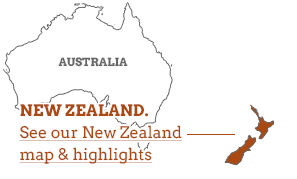A brief history of New Zealand
According to legend, Aotearoa (the original Maori name for New Zealand) was first discovered by Kupe, the great chief of the Polynesian and Maori ancestral homeland, Hawaiki, around the beginning of the 11th century. It is believed by some tribes that 40 handcrafted canoes, led by Kupe, arrived close to modern day Wellington from Eastern Polynesia and went on to settle on the mainland as well as on the Chatham Islands (Moriori) about 680km southeast.
Read more The original settlers made immediate use of a fertile volcanic landscape that had thrived due to its remoteness and lack of human habitation. Much in the same way as the dodo in Mauritius, the flightless moa bird was hunted to extinction and in so doing the descendants of the early settlers, known as the Maori, realised that their relationship with the land would have to change. Horticulture became essential with crops such as taro, sweet potatoes and gourds, brought over from Polynesia and grown to supplement a diet of wild plants like cabbage trees and fern roots. Birds and fish were also an important part of the original Maori diet and although there would be many territorial disputes with neighbouring groups (hapu) and tribes (iwi), life continued fairly self-sufficiently until the arrival of the first European visitor, Dutch explorer Abel Tasman, in 1642.
Although repelled by local Maori at Golden Bay, Tasman named the territory Staten Landt before Dutch map makers changed the name to Nova Zeelandia after the Dutch region of Zeeland. And so it remained for some 100 years until the arrival of Captain James Cook, who referred to the islands as the anglicised version we know today: New Zealand.
From that point on, British, French and US whaling and trading companies inhabited New Zealand swapping or selling tools, fish hooks and weapons for Maori supplies, including food, drink and plants such as flax. Lawless European sailors would engage in prostitution with local women and in the main relationships between tribes and traders remained fairly amicable and even sided despite the odd dispute and report of cannibalism. The advent of the 19th century found Christian missionaries visiting New Zealand in an attempt to 'convert the natives' and take charge of the unruly sailors. Many Maori accepted Christianity, for numerous reasons; however, traditional lifestyles were more significantly changed due to encounters with European settlers especially when compared with more remote tribes who had little or no contact with the increasing numbers of pakeha (non-Maori).
Trading stations became permanent, especially on North Island, during the 19th century with land being bought from Maori tribes leading to many bitter disputes with the all-colonising New Zealand Company, owned by the English, buying up huge swathes of land. This colonisation would eventually lead to the Treaty of Waitangi in 1840 which gave Maori people supposed sovereignty of their land, possessions and the rights of British citizens although there would be little sign of this in the years to follow. From that point on the British population of New Zealand increased tenfold with Maori land confiscated, traded or bought up by the European settlers. The lush grasslands on South Island made ideal pastures for rearing sheep and many of the island’s forests were cleared for agriculture. The discovery of gold in Otago and along the West Coast meant more Europeans arrived, with the first frozen exports of meat and dairy products in 1882 further cementing commercial relations and social ties with Britain. As the first country to give women the vote in 1893, New Zealand was seen as a progressive nation and remained independent from Australia but kept strong ties including establishing the ANZAC bi-nation military corps which would fight in support of the UK in WW1 and WW2.
In the second half of the 20th century, Maori families began to leave rural farms for urban areas which would lead to racial tension and a need to examine and strengthen Maori cultural identity. Similar soul searching befell New Zealand in 1973 when Britain joined the European Economic Community, which hit New Zealand’s frozen export industry hard but eventually led to a free trade deal and stronger relations with neighbours Australia. The New Zealand that you’ll find today has supplemented traditional exports with tourism, wine, fruit and timber production with Maori culture steeped in the nation’s cultural heritage as expressed in the symbolic silver fern that stems from Maori legend and holds a significant place in New Zealand’s one nation identity.
































